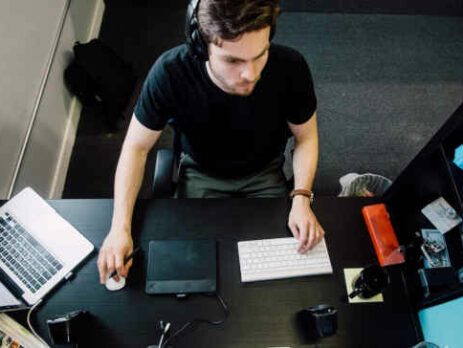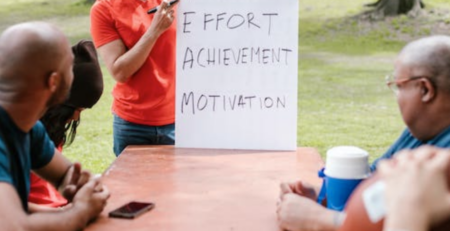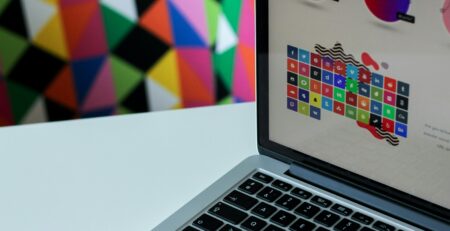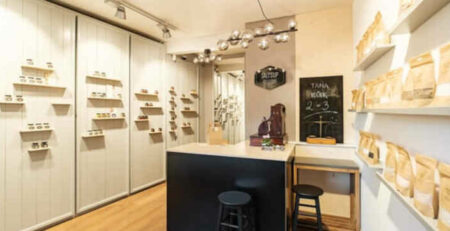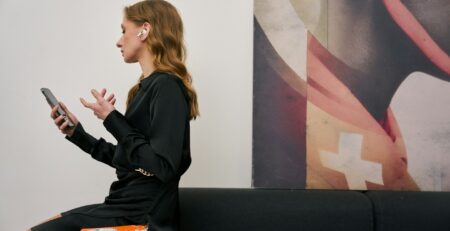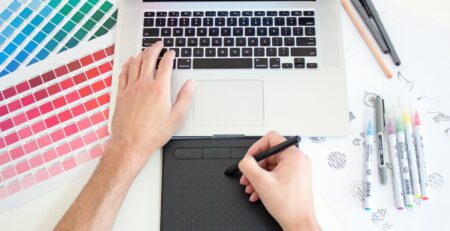The 10 Hottest Graphic Design Trends of 2020
2020 was a watershed for graphic design. Many of the trends that found footing in the last 5 or 10 years really started to blossom, along with a few that appeared to be on the way out. A more cohesive range of styles seems to be finally coalescing for the new decade, one built out of retroelements ranging from Art Deco to cyberpunk and vaporwave, covered with flowing typefaces that have broken free of the minimalist Helvetica of the naughts and teens, all embellished with incredibly vibrant colors.
There’s certainly a “look” we can ascribe to the current period of time. Partly sourced from the past but mostly a new way of combining all the disparate information at our fingertips at all times, graphic design certainly shows no signs of losing its innovative streak anytime soon.
Perplexingly, some definitive graphic design trends from 2020 have also seen their near-opposites rise to popularity alongside them. Vibrant colors are as popular as muted tones, while beveled images advertise similar services as flat line art. Abstract collage art and minimal data representations are sharing the same moment. Far from undermining the design thinking behind these choices, the appearance of such seemingly disparate style choices points to a graphic design community that is varied, curious, and inventive.
Animated sequences are making a comeback as well. Although animated GIFs have remained pretty widely used, icon-sized animated graphics had mostly gone the way of the dodo before 2020. Some of the best graphic design examples from this year are continuous or infinite animation sequences that have done a great deal to spice up the In-Stream ads on many streaming websites.
Although this year has certainly been one full of frequently unbelievable information, there is no doubt that graphic designers have come up with some effective ways to show it. For all that this has led to one-off posters with single-sentence catchphrases on them, there has also been a wealth of long-form infographics and articles that have merged with bright graphic design to create an enjoyable experience for the informed consumers of 2020.
Those trying to push the envelope on social media sites have frequently turned to design elements that make web posts look like hard copy media such as magazines or photographs. Appealing to nostalgic millennials, some of these sites have added elements with a 90s internet aesthetic to their collection of filters and photo editing tools. Cascading windows a la Microsoft Office 97 are now at users’ disposal with envelope postage stamps and disco balls.
Many things changed in 2020, but that seems to more or less be the feeling toward the end of every year. One thing that definitely did bring some concrete changes is graphic design, and the graphic design trends from this year are some of the most appealing and expandable yet. Read on for a look at the hottest graphic design trends from 2020 and some graphic design tips for next year.
Decade Rewind: Back to the Start
Before we get to some of the cool things designers came up with this year, let’s take a moment to remember what things were like in years past. The 2010s saw us run from millennial-centric vintage and minimalist designs to more airy glitch and papercut designs. There were some other short-lived trends in between as well. Here’s a quick list of some graphic design examples of the past decade:
- Gradients
Always rearing for a comeback, gradients came back in a big way early in the 2010s. As much as we’d like to say they’ve disappeared, big companies like Facebook have just recently done app logo redesigns that did little more than add a gradient to their old ones. A splash of color is always good, but a gradient can give the impression that the designer wasn’t sure which colors to pick.
- Function & Readability
These might not sound like graphic design choices to outsiders, but anyone who worked on building webpages in the last decade or more knows how big an effort it was across the industry to build websites that were free of the clutter, ads, and useless buttons of the naughts. It can be hard to believe that these two standards weren’t always front and center for designers, but at least it’s here to stay now.
- Adaptive Design
Rather than limiting themselves with a few designs for given screen sizes, designers began to use adaptive design to make sure their webpages could adjust to any screen once the parameters of that information were given. That process takes milliseconds and adaptive design has become the standard for Google and many other web giants, allowing us to view pages on our phones, tablets, computers, and wearables without issue.
- 2-Tone
It must be said that the 2010 rollout of this style was much better than the two-dimensional version used in advertising campaigns like Apple’s iPod from the early naughts. It was short-lived and probably won’t make a huge comeback, but 2-tone posters live on in certain thumbnails and continue to serve a good negative-image scroll over effect where one is applicable.
- Flatter and Simpler
Almost every major brand went through a simplification of their logos. This spirit still continues today, with some companies going so far as to take their name off and rely solely on a logo and others continuing to alter their app symbols to be more pared down. Far from the depth favored for a few years after 2012, now design seems to have settled on flat design as the simpler and more visually appealing choice.

How Did Design Tools Change in 2020?
A big reason why some of the best graphic design examples from this year look the way they do is that the design toolkit got a facelift in some pretty neat ways. As many teams were forced to start working remotely in 2020, the software used to accomplish their jobs had to change. Beyond just changing the pricing for large groups of users, software that didn’t already accommodate multiple people coworking on the same document had to figure out a way to offer that service.
Chat and conferencing software had to find a way to share large cloud-based documents and make sure that everyone was seeing the same thing without possibly exposing it to accidental edits that would ruin its contents. The big players like Adobe came out with some new programs this year and many smaller startups put their own applications out. Generally, these were all part of the great push to digitize everything, a huge part of the changes 2020 brought.
The 10 Hottest Graphic Design Trends of 2020
With all the changes that had occurred in the 10 years prior, you might say 2020 had some explaining to do more than it had big shoes to fill. Lots of the aesthetic trends in the last decade had concrete causes and some great design thinking behind them, but it’s also fair to say that the 2010s had some pretty disparate ideas floating around just about every single year of their existence.
2020 did a bit better, all things considered. Despite the current lack of certainty in some sectors, as far as graphic design is concerned, we’ve seen some of the best and most empathetic trends continue this year. Take a look at some of these stellar graphic design trends from this year.
1- Line Art
A great flourish that adds some texture even on a completely 2D design, line art has been used to emphasize text or products and guide the viewer’s eye where the designer wants it to go. It’s subtle but it can’t be ignored. You can add some of it and maintain an overall minimalism without going overboard.
2- Collage
Whether abstract or lifelike, collage is a classic way to catch a wandering eye. The seemingly unrelated elements can be used to provoke thoughtfulness in a way other methods can’t. One of the best graphic design examples of 2020 is the hand-drawn collage style. It’s interesting and allows the designer to add a wide variety of contexts to the final product.
3- Handwritten Text
It doesn’t always look like someone’s handwriting, but just about every niche item and new environmentally friendly product in the grocery store seems to have used a text script that looks handwritten. It’s a pretty big improvement on the seemingly ubiquitous sans-serif era we all endured in the late naughts. Some other typefaces have also arisen that are less handwritten but still have a flourish.
4- Thin Geometrics
Those handwritten typefaces tend to be on the bolder, wider side without a doubt. To parallel that, mane designs employ masks or line shapes that are simple geometric shapes. The coupling is a good one because it can create an enticing use of space when done correctly. Thin geometrics have also been used to fill in textless ads to great effect.
5- Abstract Elements
Sometimes three-dimensional and even interfering with the other content in the image, abstract elements have made a big splash this year. They call to mind some of the more inventive images of the future in science-fiction films, although they are very apparently from our own world. These abstract elements can be many things, from simple color designs to renderings of unspecified transparent material, among other things.
6- Cyberpunk
Cyberpunk might not be the most popular graphic design example from 2020, but it still had its own place this year. Many animated shows and video games made great use of it and more than a few ad campaigns for everything from chewing gum to shaving cream have put it to some limited use. While there weren’t many explicitly cyberpunk campaigns run by major companies this year, it’s definitely a trend to look out for in 2021.
7- Legibility is Negotiable
Further adding to some of the more general abstractions included in some of the best graphic design work this year are designs that have text that is obfuscated or completely destroyed by effects or other elements on the design. Contrary to expectations, this is a great style choice to appeal to savvy crowds who view themselves as “too well-informed” for ads and also for products that are already widely known.
8- Inclusivity
People have been demanding representation in media for a long, long time. When it first showed up on the graphic design scene, it was almost outright pandering. Then, we went through the era of the token minority. It appears that we’ve finally moved through all that and have come to a point where diversity is a widely acknowledged good, and as such is appearing quite naturally in designs in many industries.
9- Realism
But not your father’s gritty reboot realism. In 2020, companies are making some true-to-life representations of people in their everyday lives. They’re still trending toward the affluent and people who can afford their products by and large, but many designs forwent the airbrushing this year. It’s all part of people getting a bit savvier – the design story has to be more believable now, perhaps, than ever before.
10- Animation
Short introduction videos and animated text overlaid on top of a video were put to good use this year. Some other good examples of animation were the steady decline of the whooshing motion graphics that rose to prominence in the naughts and for some reason haven’t left us yet. Though most prominent on sports and news networks, these old styles of animations don’t hold a candle to the smooth infinite animations used by many designers this year.
Graphic Design Tips for 2021
One of the most honest things about graphic design in 2020 was that no one seemed to make any definite promises about next year. Given the tumult of this year, it makes sense. But that doesn’t mean there aren’t any smart predictions at all. Use some of these graphic design tips to stay ahead of the curve in 2021:
- Animation
It’s very likely that more animation will be needed as people are more and more often viewing content on iPads and on other devices with technology that can handle motion without interruption.
- Muted & Vibrant Colors
The clash between seemingly opposed elements like bright colors and muted tones will grow into something akin to the 2-tone design next year. Think of a more abstract version where the muted tones are in the shadows of the vibrant, leaving negative space in places where text can be creatively placed.
- Masking
Something about the simple masking tool is incredibly appealing. Perhaps the unseen part of the design provokes humans’ natural curiosity, inviting them to see more if they engage with the product. Whatever the psychological reason, it’s a beautiful design when it’s properly done. Look for it to reach new heights next year.
- Reduced Simplification
It might be too soon to give graphic design tips like this, but the simplification movement has been running for about 15 years at a minimum. Some of these corporate and social media logos can’t get any more simple without being uncopyrightable. If it’s not in 2021, look for some rebranding projects that add a bit more detail to these logos.
- Minimalism
The minimalist code will be played with a ton next year. Even though we all respect negative space, people have begun to try and inject a sense of humor into how sparse their designs can be. Look for more of that in 2021.
- Vintage
One graphic design tip that will never get old is that vintage will never die. But next year don’t be surprised if some of the “vintage” designs you see are from the early 2000s. As nonsensical as it may be, the timeline for what’s vintage continues to be pushed forward so that people can reclaim older ideas before others can. Hopefully, it doesn’t go too far.

Conclusion:
2020 made sure it would stand apart from the decade preceding it. Graphic design is always moving and it seemed to pick up on the insanity of this year with gusto. Although you might not be able to pick out anything that was absolutely brand new this year, all the elements from years prior were consolidated into some of the best design work seen in years.
There’s no way to know for sure what next year will bring, but hopefully identifying graphic design examples from this year and leaving some of our best graphic design tips for 2021 will help everyone stay sharp and bring design to new and exciting heights.
If you need any help finding work in the new year, don’t hesitate to contact icreatives!

